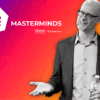
From Insight to Impact – How to Drive Better Decision Making With People Analytics
today2022.02.25. 118

As the legendary engineer W. Edwards Deming once said, “Without data you are just another person with an opinion.”
The rise of the importance and priority of Data-Driven Decision Making in HR provides for accountability, transparency, and frankly an opportunity to make better business decisions. This approach is opposed to basing those decisions on instinct or speculations that may lead to people riskily acting on biases and false assumptions.
Why is data-driven decision making considered better? Simply put, data provides context and knowledge. To further discuss this, during The HR Congress World Summit we gathered some of the most prominent figures in people analytics to share their views on how to move from insights to impact in order to support better decision making.
The Facilitator of the panel was Nigel Dias, Managing Director, 3n Strategy and Chair, from the HR Analytics ThinkTank. The four panelists were Jeremy Shapiro, Executive Director Workforce Analytics from MERCK, Gishan Nissanka, Global People Analytics, Digital Talent, from EY, Madhura Chakrabarti, Global Head, People Analytics, from Syngenta, and Sarah Andresen, Principal People Scientist, from the AI Labs of Sage.
Nigel kicked off the panel with an engaging question: “What is your favorite type of HR question and why – where are you not only making interesting analytics but also provide business impact?”
Madhura talked about how, based on anecdotal conversation, she got the general impression after her employee listening exercise that everyone is “generally feeling better.” However, after adding numbers to these conversations, it turned out 60-70% of people actually preferred a hybrid solution instead of going back to the office full-time or going off-site completely.
“The moment you add numbers to the conversations you see that it gets picked up by our CHRO and even by our CEO.”
Madhura Chakrabarthi
Secondly, Madhura spoke about applying numbers to answering concrete business questions – such as predicting who has the best sales performance – which resulted in the sales strategy team responding “This is the best HR involvement we have had, and we never thought HR could help us in such a way.”
Gishan responded to the current hype about the “Great Resignation” and spoke about how looking at the drivers of why people are leaving or why they choose to stay helps with retention during the time of “the Great Resignation.” This is a really valuable topic where people analytics teams can add value.
Sarah joined the conversation by emphasizing the importance of connecting the dots between HR and business data to really start linking what’s going on with people insights and how they are driving business metrics that businesses truly care about.
Get the Ebook: Four Steps to Better People Analytics
SAGE
In addition, exciting opportunities for machine learning within the people analytics space have emerged recently. Some of the projects the individuals on the panel are working on really take the power of machine learning and make it available to smaller and mid-sized companies.
Jeremy Shapiro shared details about analytical research on data science and analytical talent across the entire company that helped outline some of the quickly occurring changes. There are so many changes in data science today that the base of reference for the title of “Data Engineer” has changed in the past 12 months. Based on this, we can create better learning pathways and networking opportunities so that you can really get a feel for how some of these emerging functions operate and improve them.
What is the secret ingredient for how to actually create an impact with people analytics?
As a secret ingredient, Gishan advised on “relationship” – analytics business partnering. It is important to reach out to the analytics team, ask them hard questions, ask for help, and get familiar with the approach. As he pointed out, over the pandemic we have seen that most decisions were made based on data science – it is beginning to appear in all areas of our lives and will only continue to become more and more prevalent.
It all comes down to knowing your people, asking good questions, asking for feedback, and then using that feedback to ask better questions. The ultimate goal is to really understand their needs.
Madhura jumped in and mentioned that people analytics is never a linear journey. So while you sometimes feel you are on level one or two and struggle with basic infrastructure or educating business leaders on how to read a dashboard, maybe there is an opportunity the next day to pitch an idea for ONA, a level 4 idea. These two ends of spectrum can go hand-in-hand, so don’t be too concerned whether you are at level 2 or 4. While models are great and useful, people analytics is not a linear journey.
Next there was a question from the audience: “How do we use people analytics to help employees make better decisions?” Jeremy and Gishan both agreed that sharing the analytics with the employees can really help motivate them and improve their performance.
Sarah emphasized on the importance of knowing your audience and understanding both their needs and where they need data to overcome challenges. This iterative process requires regular check-ins and adjustments so that you can be a true source of value.
Nigel then asked everyone to summarize their advice to HR professionals in one sentence:
Sara – “Knowing your people, understanding them and their decisions gives you an enormous competitive advantage.”
Madhura – “Upscale the entire HR population – it will have an exponential impact, which can never compare to a single analytics team.”
Gishan – “The bigger the question, the better the answer. Ask bigger and better questions – analytics is all about finding answers.”
Jeremy – “Use data, provide context.”
There was a wealth of valuable insights from the panelists throughout the discussion, so watch the video below to find out more.
Written by: Mihaly Nagy
HR Strategy HR Tech People Analytics
Previous post

- 1518
labelArticles today2022.02.24.
Finding Strength in Adversity: Talent Resolutions for 2022
By David C Forman, Author of “Fearless Talent Choices” WHY SHOULD YOU CARE? We face challenges never seen before that created new circumstances for organizations to adapt and innovate. Capitalizing [...]
Similar posts

labelArticles today2024.10.21.
The success-recipe to build agile and future-ready organizations in 2025 and beyond







Post comments (0)